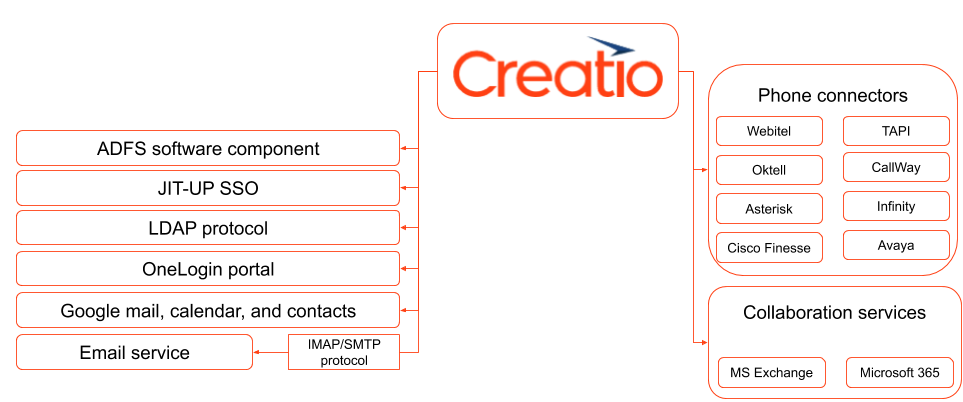Integrations
Glossary Item Box

Software system and product integration is data exchange between the systems, with or without subsequent data processing. The point of integration is to transfer the user’s data input from one system to another automatically.
Creatio’s open API supports creating integration solutions of any complexity.
Integration of external applications with Creatio
Creatio has a wide range of integrations with custom third-party applications. The choice of the integration method depends on the needs of the customer, the type and architecture of the external application, and the expertise level of the developer.
You need to authenticate your requests to Creatio.
Integration with Creatio entails achieving the following objectives:
- CRUD operations with Creatio objects.
- Launching business processes.
- User tasks can be solved within the open Creatio API.
Creatio provides the following integration options for CRUD operations:
- The OData protocol.
- The DataService web service, developed by Creatio.
The Creatio integration scheme for external applications is presented in Figure 1.
Fig. 1. Integration of external applications with Creatio

The OData service
OData (Open Data Protocol) is an ISO/IEC-approved OASIS standard. It defines a set of best practices for building and consuming REST APIs. It enables creating REST-based services that allow web clients to publish and edit resources using simple HTTP requests. Such resources should be identified with a URL and defined in the data model.
Learn about the protocol in more detail in the OData documentation.
Creatio supports OData 3 and OData 4 protocols. OData 4 replaces OData 3 and enhances the capacity of the predecessor protocol considerably. The protocols are not compatible concerning the format of data returned by the servers.
To integrate with Creatio, use OData 4.
Learn more about Creatio integration using OData version 3 and 4 in the “Integration via OData protocol” block of articles.
The DataService web service
The DataService web service is the main link between the Creatio client and server parts. It helps to transfer the data entered in the UI by the user to the server-side of the application for further processing and saving to the database.
Learn more about Creatio integration via DataService and the major operations supported by the service in the “DataService” article.
Business process launcher service (ProcessEngineService)
Running the business processes is one of the purposes of integrating an external application with Creatio. The Creatio service model implements the ProcessEngineService.svc web service for launching business processes from an external application.
Learn more about Creatio integration using the web service in the “The ProcessEngineService.svc web service” article.
Custom configuration web service
Creatio enables to create custom web services in the configuration that can implement specific integration tasks. The configuration web service is a RESTful service based on WCF technology.
Learn more about creating a custom configuration web service in the “Creating a user configuration service” article.
Creatio integration with third-party applications
Use the low-code/no-code integration tools to combine different corporate applications into a single digital ecosystem. Learn about the low-code and no-code tools in more detail in the “Low-code and no-code development” article.
Develop integration solutions
Creatio supports integration with a custom RESTful API via no-code tools. After setting up a web-service integration, you can call it from a business process. The REST API tools support interaction with third-party web services without coding.
Learn more about web service integration in the “Calling web services from business processes” article.
Out-of-the-box integration solutions
The scheme of out-of-the-box Creatio integration solutions is presented in Figure 2.
Fig. 2. Out-of-the-box Creatio integration solutions

You can integrate Creatio with the following external applications:
- the OneLogin SSO portal, used as a single sign-on point for all your services, including Creatio. Learn more about OneLogin integration in the “Setting up Single Sign-On via OneLogin” article.
- the Active Directory Federation Services (ADFS) software component used for managing single sign-on for all system users. Learn more about Active Directory Federation Services integration in the “Setting up Single Sign-On via ADFS” article.
- the Just-In-Time User Provisioning (JIT UP) Single Sign-On, which alleviates the need to create accounts for each separate service and keep the user database up-to-date. Learn more about Just-In-Time User Provisioning integration in the “Setting up Jusy-In-Time User Provisioning” article.
- the Lightweight Directory Access Protocol (LDAP), which enables access to the dedicated database used to store the credentials of users, machines, etc. Learn more about Lightweight Directory Access Protocol integration in the “Setting up LDAP integration” article.
- email providers by the IMAP/SMTP protocol. Learn more about email integration via the IMAP/SMTP protocol in the “Integration with email services by the IMAP/SMTP protocol” article.
- Google mail, calendar, and contacts. Learn more about integration with Google in the “Integration with Google services” article.
- phone connectors, such as Webitel, Oktell, Asterisk, Cisco Finesse, TAPI, CallWay, Infinity, and Avaya.
- the MS Exchange and Microsoft 365 collaboration services. Learn more about MS Exchange and Microsoft 365 integration in the “Integration with the MS Exchange and Microsoft 365 services” article.
See also
- External requests authentication to Creatio services
- The ProcessEngineService.svc web service
- DataService
- Integration via OData protocol
- Integrations
Video tutorial
- Integrations. Calling external web-services from the program code
- Data integration. Working with OData/DataService












